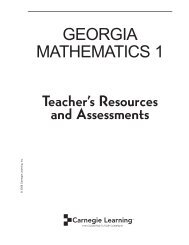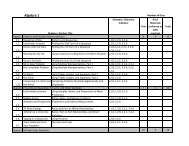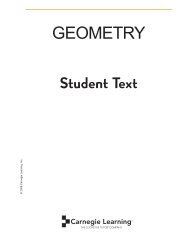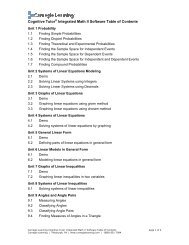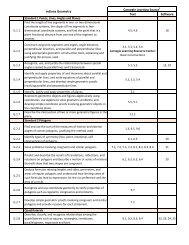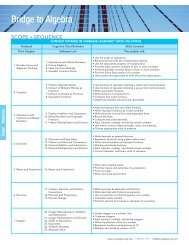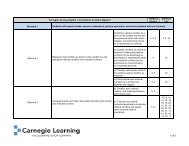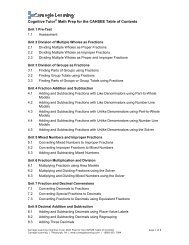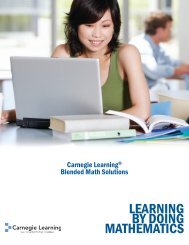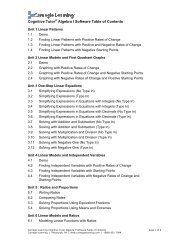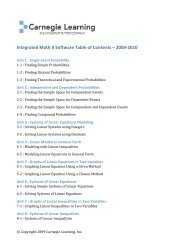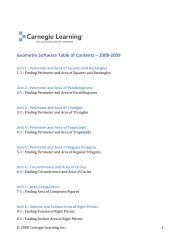GEORGIA MATHEMATICS 1 - Carnegie Learning
GEORGIA MATHEMATICS 1 - Carnegie Learning
GEORGIA MATHEMATICS 1 - Carnegie Learning
Create successful ePaper yourself
Turn your PDF publications into a flip-book with our unique Google optimized e-Paper software.
© 2008 <strong>Carnegie</strong> <strong>Learning</strong>, Inc.<br />
<strong>GEORGIA</strong><br />
<strong>MATHEMATICS</strong> 1<br />
Teacher’s Resources<br />
and Assessments
© 2008 <strong>Carnegie</strong> <strong>Learning</strong>, Inc.<br />
Pre-Test<br />
Name ___________________________________________________ Date _____________________<br />
1. In the figure shown below, PW � NC, PA � NK, and AC � KW.<br />
Determine whether<br />
�PAW is congruent to �NKC. Use complete sentences to justify your reasoning.<br />
2. In the figure shown below, �RAC � �YTC. Determine which angle is congruent to �CRA.<br />
R<br />
P<br />
E<br />
A C W K<br />
A C<br />
N<br />
T<br />
Y<br />
Georgia Mathematics 1 Chapter 7 ■ Assessments 161<br />
7
7<br />
Pre-Test PAGE 2<br />
3. In the figure shown below, DG � GE<br />
and �GDP � �GEH.<br />
Determine whether �GDP is<br />
congruent to �GEH. Use complete sentences to justify your reasoning.<br />
E<br />
4. Using the figure shown below, determine whether �TAR is congruent to �PAR.<br />
Use complete sentences to justify your reasoning.<br />
T<br />
D<br />
A<br />
F<br />
P<br />
H<br />
R P<br />
162 Chapter 7 ■ Assessments Georgia Mathematics 1<br />
G<br />
© 2008 <strong>Carnegie</strong> <strong>Learning</strong>, Inc.
© 2008 <strong>Carnegie</strong> <strong>Learning</strong>, Inc.<br />
Pre-Test PAGE 3<br />
Name ___________________________________________________ Date _____________________<br />
5. Sketch two triangles with appropriate markings that are congruent by using<br />
HL Congruence Postulate.<br />
6. In �CAT and �DQG, AC � QD,<br />
CT � DG,<br />
and �A � �Q.<br />
Name one additional piece of<br />
information that is needed to prove �CAT � �DQG?<br />
Use complete sentences to justify<br />
your reasoning.<br />
Georgia Mathematics 1 Chapter 7 ■ Assessments 163<br />
7
7<br />
164 Chapter 7 ■ Assessments Georgia Mathematics 1<br />
© 2008 <strong>Carnegie</strong> <strong>Learning</strong>, Inc.
© 2008 <strong>Carnegie</strong> <strong>Learning</strong>, Inc.<br />
Post-Test<br />
Name ___________________________________________________ Date _____________________<br />
1. In the figure shown below, PA � NK and NA � PK.<br />
Determine whether �PAN is<br />
congruent to �NKP. Use complete sentences to justify your reasoning.<br />
A<br />
2. Using the figure shown below, determine whether �RAC is congruent to �YTC.<br />
Use complete<br />
sentences to justify your reasoning.<br />
R<br />
P N<br />
E<br />
A<br />
K<br />
C<br />
T<br />
Georgia Mathematics 1 Chapter 7 ■ Assessments 165<br />
Y<br />
7
7<br />
Post-Test PAGE 2<br />
3. In the figure shown below, DF � EF<br />
and �GHE � �GPD.<br />
Determine whether<br />
�DFH � �EFP. Use complete sentences to justify your reasoning.<br />
E<br />
D<br />
4. Using the figure shown below, �T � �P and AR bisects TP. Determine whether<br />
�TAR � �PAR. Use complete sentences to justify your reasoning.<br />
A<br />
P<br />
H<br />
T R<br />
P<br />
F<br />
166 Chapter 7 ■ Assessments Georgia Mathematics 1<br />
G<br />
© 2008 <strong>Carnegie</strong> <strong>Learning</strong>, Inc.
© 2008 <strong>Carnegie</strong> <strong>Learning</strong>, Inc.<br />
Post-Test PAGE 3<br />
Name ___________________________________________________ Date _____________________<br />
5. In the isosceles trapezoid shown below, AV � RM and Q is the midpoint of VM.<br />
Determine whether �RAQ � �ARQ. Use complete sentences to justify your reasoning.<br />
A R<br />
V Q M<br />
6. Sketch �BAG and �REG such that BA � RE, �B � �R, and they are congruent by<br />
using AAS Congruent Postulate.<br />
Georgia Mathematics 1 Chapter 7 ■ Assessments 167<br />
7
7<br />
168 Chapter 7 ■ Assessments Georgia Mathematics 1<br />
© 2008 <strong>Carnegie</strong> <strong>Learning</strong>, Inc.
© 2008 <strong>Carnegie</strong> <strong>Learning</strong>, Inc.<br />
Mid-Chapter Test<br />
Name ___________________________________________________ Date _____________________<br />
1. In parallelogram HPJM, HP || MJ<br />
and MP is a diagonal. Determine whether<br />
�HPM � �JMP.<br />
Use complete sentences to justify your reasoning.<br />
2. In the figure shown below, AN bisects the vertex angle of isosceles triangle YAW.<br />
Determine whether AN is a segment bisector of YW. Use complete sentences to justify<br />
your reasoning.<br />
A<br />
Y N W<br />
Georgia Mathematics 1 Chapter 7 ■ Assessments 169<br />
7
7<br />
Mid-Chapter Test PAGE 2<br />
3. Using the figure shown below, determine whether �R � �Y.<br />
Use complete sentences to<br />
justify your reasoning.<br />
R<br />
4. Triangle ABC is congruent to triangle XYZ. Name all pairs of corresponding parts.<br />
5. In the figure shown below, quadrilateral ABCD is a rectangle with diagonal DB.<br />
Determine whether �ABD � �CDB. Use complete sentences to justify your reasoning.<br />
A B<br />
D<br />
A<br />
C<br />
C<br />
T<br />
170 Chapter 7 ■ Assessments Georgia Mathematics 1<br />
Y<br />
© 2008 <strong>Carnegie</strong> <strong>Learning</strong>, Inc.
© 2008 <strong>Carnegie</strong> <strong>Learning</strong>, Inc.<br />
End of Chapter Test<br />
Name ___________________________________________________ Date _____________________<br />
1. Name all of the pairs of congruent triangles in the figure drawn below and state why each<br />
pair of triangles is congruent.<br />
R<br />
2. In the figure shown below, PE � RA and PA � RE.<br />
Determine whether quadrilateral PARE<br />
is a parallelogram. Use complete sentences to justify your reasoning.<br />
P A<br />
E<br />
I<br />
T<br />
R<br />
G<br />
H<br />
Georgia Mathematics 1 Chapter 7 ■ Assessments 171<br />
7
7<br />
End of Chapter Test PAGE 2<br />
3. Using the figure shown below, determine whether �HAW � �TAW.<br />
Use complete<br />
sentences to justify your reasoning.<br />
W<br />
H<br />
T<br />
4. In the figure shown below, CQ � WQ,<br />
and HC � HW.<br />
Determine whether<br />
�CHQ � �WHQ.<br />
Use complete sentences to justify your reasoning.<br />
H<br />
Q<br />
A<br />
C W<br />
172 Chapter 7 ■ Assessments Georgia Mathematics 1<br />
© 2008 <strong>Carnegie</strong> <strong>Learning</strong>, Inc.
© 2008 <strong>Carnegie</strong> <strong>Learning</strong>, Inc.<br />
End of Chapter Test PAGE 3<br />
Name ___________________________________________________ Date _____________________<br />
5. In the figure shown below, BD bisects AC and AB � BC.<br />
Determine whether<br />
�ADB and �CDB are right triangles. Use complete sentences to justify your reasoning.<br />
A<br />
6. In the figure shown below, QP � AP and AY � QY.<br />
Determine whether �Q � �A.<br />
Use complete sentences to justify your reasoning.<br />
R<br />
W<br />
K<br />
B<br />
D<br />
P<br />
C<br />
Y<br />
Q<br />
A<br />
Georgia Mathematics 1 Chapter 7 ■ Assessments 173<br />
7
7<br />
End of Chapter Test PAGE 4<br />
7. In the figure shown below, �J � �X and JD � XD.<br />
Use complete sentences to justify your reasoning.<br />
Determine whether BD � CD.<br />
B C<br />
D<br />
J X<br />
174 Chapter 7 ■ Assessments Georgia Mathematics 1<br />
© 2008 <strong>Carnegie</strong> <strong>Learning</strong>, Inc.
© 2008 <strong>Carnegie</strong> <strong>Learning</strong>, Inc.<br />
Standardized Test Practice<br />
Name ___________________________________________________ Date _____________________<br />
1. Which of these cannot be used to prove that two triangles are congruent?<br />
a. AA<br />
b. SAS<br />
c. AAS<br />
d. HL<br />
Use the figure below to answer Questions 2 and 3. In the figure, GM � MO<br />
and EO � MO.<br />
G E<br />
M<br />
2. �GMO � �EOM by:<br />
a. SAS<br />
b. AA<br />
c. HL<br />
d. Not enough information is given to determine if the triangles are congruent<br />
3. �MTG � �MTO by:<br />
a. SSS<br />
b. AA<br />
c. SAS<br />
T<br />
d. Not enough information is given to determine if the triangles are congruent<br />
Georgia Mathematics 1 Chapter 7 ■ Assessments 175<br />
O<br />
7
7<br />
Standardized Test Practice PAGE 2<br />
Use the figure shown below to answer Questions 4 through 6.<br />
4. Given: �BUN is isosceles with BU � BN.<br />
What additional given information is needed to<br />
prove �BUG � �BNA by ASA?<br />
a.<br />
b.<br />
c.<br />
d.<br />
5. Triangle BAG is isosceles with BG � BA.<br />
What is one additional piece of information that<br />
is needed to prove �BGN � �BAU by SAS?<br />
a.<br />
b.<br />
c.<br />
d.<br />
�UBA � �NBG<br />
�UBG � �NBA<br />
�BGU � �BAN<br />
�BUG � �BNA<br />
GN � AU<br />
BU � BN<br />
GU � AN<br />
AG � GA<br />
B<br />
U G A N<br />
6. If �UBG � �NBA,<br />
why is �UBA � �NBG?<br />
a. Reflexive Property<br />
b. Transitive Property<br />
c. Angle addition<br />
d. Definition of congruent angles<br />
176 Chapter 7 ■ Assessments Georgia Mathematics 1<br />
© 2008 <strong>Carnegie</strong> <strong>Learning</strong>, Inc.
© 2008 <strong>Carnegie</strong> <strong>Learning</strong>, Inc.<br />
Standardized Test Practice PAGE 3<br />
Name ___________________________________________________ Date _____________________<br />
7. Points G, E, and T form a triangle. GE � TR,<br />
GP � TQ,<br />
and PE � QR.<br />
Which triangle is<br />
�GEP congruent to?<br />
a.<br />
b.<br />
c.<br />
d.<br />
�RTQ<br />
�QTR<br />
�TQR<br />
�TRQ<br />
8. Using the diagram shown at the right, choose the<br />
correct conclusion.<br />
a. The triangles are congruent by SSS.<br />
b. The triangles are congruent by ASA.<br />
c. The triangles are congruent by SAS.<br />
d. Not enough information to determine if the triangles<br />
are congruent.<br />
9. Using the diagram shown at the right, choose the<br />
correct conclusion.<br />
a. The triangles are congruent by SSS.<br />
b. The triangles are congruent by ASA.<br />
c. The triangles are congruent by SAS.<br />
d. Not enough information to determine if the triangles<br />
are congruent.<br />
10. In the diagram shown at the right, PN is parallel to JQ,<br />
KN � 16 centimeters, PN � 8 centimeters, and JQ � 14 centimeters.<br />
Find the length of NQ.<br />
a. 28 cm<br />
b. 12 cm<br />
c. 9.1 cm<br />
d. 7 cm<br />
Georgia Mathematics 1 Chapter 7 ■ Assessments 177<br />
R<br />
A<br />
20 0<br />
P<br />
J<br />
C<br />
K<br />
20 0<br />
T<br />
N<br />
Y<br />
Q<br />
7
Standardized Test Practice PAGE 4<br />
7<br />
11. In the figure shown below, �ABD and �BCD are isosceles triangles and �ABD � �CBD.<br />
�ABD � �CBD by:<br />
A<br />
a. SSS<br />
b. SAS<br />
c. AAS<br />
d. HL<br />
12. In the figure shown below, PS � RQ. �SQR � �QSP by:<br />
P Q<br />
a. SSS<br />
b. SAS<br />
c. AAS<br />
d. HL<br />
B<br />
D<br />
S<br />
C<br />
R<br />
178 Chapter 7 ■ Assessments Georgia Mathematics 1<br />
© 2008 <strong>Carnegie</strong> <strong>Learning</strong>, Inc.
© 2008 <strong>Carnegie</strong> <strong>Learning</strong>, Inc.<br />
Pre-Test<br />
Name ___________________________________________________ Date _____________________<br />
1. In the figure shown below, PW � NC, PA � NK, and AC � KW.<br />
Determine whether<br />
�PAW is congruent to �NKC. Use complete sentences to justify your reasoning.<br />
A C W K<br />
2. In the figure shown below, �RAC � �YTC. Determine which angle is congruent to �CRA.<br />
R<br />
P<br />
E<br />
A C<br />
�CRA � �CYT<br />
N<br />
Sample Answer: It is given that PW � NC<br />
and PA � NK. AW � KC because AC � KW<br />
and CW is added to each to form the triangle side. Therefore, �PAW � �NKC by<br />
SSS Congruence Postulate.<br />
T<br />
Y<br />
Georgia Mathematics 1 Chapter 7 ■ Assessments 161<br />
7
7<br />
Pre-Test PAGE 2<br />
3. In the figure shown below, DG � GE and �GDP � �GEH.<br />
Determine whether �GDP is<br />
congruent to �GEH. Use complete sentences to justify your reasoning.<br />
E<br />
4. Using the figure shown below, determine whether �TAR is congruent to �PAR.<br />
Use complete sentences to justify your reasoning.<br />
T<br />
D<br />
A<br />
F<br />
P<br />
H<br />
Sample Answer: Angle G is shared by both triangles. One other pair of angles and pair of<br />
included sides are also congruent, so �GDP � �GEH<br />
by ASA Congruence Postulate.<br />
R P<br />
Sample Answer: In the figure, TR � PR. Side AR is shared by both triangles. All right<br />
angles are congruent, so �TRA � �PRA. Therefore, �TAR � �PAR by SAS Congruence<br />
Postulate.<br />
162 Chapter 7 ■ Assessments Georgia Mathematics 1<br />
G<br />
© 2008 <strong>Carnegie</strong> <strong>Learning</strong>, Inc.
© 2008 <strong>Carnegie</strong> <strong>Learning</strong>, Inc.<br />
Pre-Test PAGE 3<br />
Name ___________________________________________________ Date _____________________<br />
5. Sketch two triangles with appropriate markings that are congruent by using<br />
HL Congruence Postulate.<br />
Sample Answer:<br />
6. In �CAT and �DQG, AC � QD,<br />
CT � DG,<br />
and �A � �Q.<br />
Name one additional piece of<br />
information that is needed to prove �CAT � �DQG?<br />
Use complete sentences to justify<br />
your reasoning.<br />
Sample Answer: The triangles are congruent using ASA Congruence Postulate if<br />
�C � �D. The triangles are congruent using SAS Congruence Postulate if AT � QG.<br />
Georgia Mathematics 1 Chapter 7 ■ Assessments 163<br />
7
7<br />
164 Chapter 7 ■ Assessments Georgia Mathematics 1<br />
© 2008 <strong>Carnegie</strong> <strong>Learning</strong>, Inc.
© 2008 <strong>Carnegie</strong> <strong>Learning</strong>, Inc.<br />
Post-Test<br />
Name ___________________________________________________ Date _____________________<br />
1. In the figure shown below, PA � NK and NA � PK. Determine whether �PAN is<br />
congruent to �NKP. Use complete sentences to justify your reasoning.<br />
A<br />
2. Using the figure shown below, determine whether �RAC is congruent to �YTC.<br />
Use complete<br />
sentences to justify your reasoning.<br />
R<br />
P N<br />
E<br />
A<br />
K<br />
Sample Answer: Side PN is shared by both triangles. The other two pairs of<br />
corresponding sides are equal, so �PAN � �NKP by SSS Congruence Postulate.<br />
C<br />
T<br />
Sample Answer: In the figure, AR � TY<br />
and AC � TC. Angle RCA and angle YCT are<br />
vertical angles, so �RCA � �YCT. So, two pairs of sides and a pair of non-included<br />
angles are known. Because the SAS Congruence Postulate must use the included angles,<br />
there is not enough information to determine whether the triangles are congruent.<br />
Georgia Mathematics 1 Chapter 7 ■ Assessments 165<br />
Y<br />
7
7<br />
Post-Test PAGE 2<br />
3. In the figure shown below, DF � EF and �GHE � �GPD.<br />
Determine whether<br />
�DFH � �EFP. Use complete sentences to justify your reasoning.<br />
E<br />
D<br />
4. Using the figure shown below, �T � �P and AR bisects TP. Determine whether<br />
�TAR � �PAR. Use complete sentences to justify your reasoning.<br />
A<br />
P<br />
H<br />
T R<br />
P<br />
F<br />
Sample Answer: Supplements of congruent angles are congruent, so �DHF � �EPF.<br />
Vertical angles are congruent, so �DFH � �EFP. �DFH � �EFP by AAS Congruence<br />
Postulate.<br />
Sample Answer: If �T � �P then �TAP is isosceles and AT � AP. By definition of bisect,<br />
TR � PR. So, �TAR � �PAR by SAS Congruence Postulate.<br />
166 Chapter 7 ■ Assessments Georgia Mathematics 1<br />
G<br />
© 2008 <strong>Carnegie</strong> <strong>Learning</strong>, Inc.
© 2008 <strong>Carnegie</strong> <strong>Learning</strong>, Inc.<br />
Post-Test PAGE 3<br />
Name ___________________________________________________ Date _____________________<br />
5. In the isosceles trapezoid shown below, AV � RM and Q is the midpoint of VM.<br />
Determine whether �RAQ � �ARQ. Use complete sentences to justify your reasoning.<br />
A R<br />
V Q M<br />
Sample Answer: Base angles of an isosceles trapezoid are equal, so �V � �M.<br />
So,<br />
�VAQ � �MRQ by SAS Congruence Postulate. Corresponding parts of congruent<br />
triangles are congruent, so AQ � RQ. Triangle AQR is isosceles and base angles of an<br />
isosceles triangle are congruent, so �RAQ � �ARQ.<br />
6. Sketch �BAG and �REG such that BA � RE, �B � �R, and they are congruent by<br />
using AAS Congruent Postulate.<br />
Sample Answer:<br />
B<br />
A<br />
G<br />
E<br />
R<br />
Georgia Mathematics 1 Chapter 7 ■ Assessments 167<br />
7
7<br />
168 Chapter 7 ■ Assessments Georgia Mathematics 1<br />
© 2008 <strong>Carnegie</strong> <strong>Learning</strong>, Inc.
© 2008 <strong>Carnegie</strong> <strong>Learning</strong>, Inc.<br />
Mid-Chapter Test<br />
Name ___________________________________________________ Date _____________________<br />
1. In parallelogram HPJM, HP || MJ and MP is a diagonal. Determine whether<br />
�HPM � �JMP.<br />
Use complete sentences to justify your reasoning.<br />
Sample Answer: Alternate interior angles formed by parallel lines are congruent,<br />
so �HPM � �JMP<br />
and �PMH � �MPJ. Side MP is shared by both triangles.<br />
So, �HPM � �JMP by ASA Congruence Postulate.<br />
2. In the figure shown below, AN bisects the vertex angle of isosceles triangle YAW.<br />
Determine whether AN is a segment bisector of YW. Use complete sentences to justify<br />
your reasoning.<br />
A<br />
Y N W<br />
Sample Answer: By definition of bisect, �YAN � �WAN. By definition of isosceles<br />
triangle, AY � AW. Side AN is shared by both triangles. Therefore, �YAN � �WAN by<br />
SAS Congruence Postulate. Corresponding parts of congruent triangles are congruent,<br />
so YN � WN. By definition of segment bisector, AN is a segment bisector of YW.<br />
Georgia Mathematics 1 Chapter 7 ■ Assessments 169<br />
7
7<br />
Mid-Chapter Test PAGE 2<br />
3. Using the figure shown below, determine whether �R � �Y.<br />
Use complete sentences to<br />
justify your reasoning.<br />
R<br />
4. Triangle ABC is congruent to triangle XYZ. Name all pairs of corresponding parts.<br />
5. In the figure shown below, quadrilateral ABCD is a rectangle with diagonal DB.<br />
Determine whether �ABD � �CDB. Use complete sentences to justify your reasoning.<br />
A B<br />
D<br />
A<br />
C<br />
C<br />
T<br />
Sample Answer: In the figure, AR � TY and AC � TC. Angle RCA and �YCT are vertical<br />
angles, so �RCA � �YCT. So, two pairs of sides and a pair of non-included angles are<br />
known. Because the SAS Congruence Postulate must use the included angles, there is not<br />
enough information to determine whether the triangles are congruent and it is also<br />
unknown whether the corresponding angles, �R and �Y,<br />
are congruent.<br />
�A � �X<br />
�B � �Y<br />
�C � �Z<br />
AB � XY<br />
BC � YZ<br />
AC � XZ<br />
Sample Answer: Side BD is shared by both triangles. By definition of rectangle, AB � CD<br />
and AD � CB. So, �ABD � �CDB by SSS Congruence Postulate.<br />
170 Chapter 7 ■ Assessments Georgia Mathematics 1<br />
Y<br />
© 2008 <strong>Carnegie</strong> <strong>Learning</strong>, Inc.
© 2008 <strong>Carnegie</strong> <strong>Learning</strong>, Inc.<br />
End of Chapter Test<br />
Name ___________________________________________________ Date _____________________<br />
1. Name all of the pairs of congruent triangles in the figure drawn below and state why each<br />
pair of triangles is congruent.<br />
R<br />
2. In the figure shown below, PE � RA and PA � RE.<br />
Determine whether quadrilateral PARE<br />
is a parallelogram. Use complete sentences to justify your reasoning.<br />
P A<br />
E<br />
I<br />
T<br />
R<br />
G<br />
H<br />
�GHI � �TIH by HL Congruence Postulate, �TIH � �ITR by SAS Congruence Postulate,<br />
and �GHI � �ITR by the Transitive Property.<br />
Side AE<br />
is shared by both triangles. So, �PAE � �REA by SSS Congruence Postulate.<br />
Corresponding parts of congruent triangles are congruent, so �EAR � �AEP and<br />
�EAP � �AER.<br />
If alternate interior angles are congruent, then lines are parallel, so<br />
AR || PE and PA || ER. Opposite sides are parallel, so quadrilateral ABCD is a<br />
parallelogram.<br />
Georgia Mathematics 1 Chapter 7 ■ Assessments 171<br />
7
7<br />
End of Chapter Test PAGE 2<br />
3. Using the figure shown below, determine whether �HAW � �TAW. Use complete<br />
sentences to justify your reasoning.<br />
W<br />
H<br />
T<br />
4. In the figure shown below, CQ � WQ,<br />
and HC � HW.<br />
Determine whether<br />
�CHQ � �WHQ.<br />
Use complete sentences to justify your reasoning.<br />
H<br />
Q<br />
A<br />
Sample Answer: Side WA<br />
is shared by both triangles. So, �HAW � �TAW by<br />
HL Congruence Postulate.<br />
C W<br />
Sample Answer: Side HQ is shared by both triangles. So, �CHQ � �WHQ by SSS<br />
Congruence Postulate. Corresponding parts of congruent triangles are congruent,<br />
so �CHQ � �WHQ.<br />
172 Chapter 7 ■ Assessments Georgia Mathematics 1<br />
© 2008 <strong>Carnegie</strong> <strong>Learning</strong>, Inc.
© 2008 <strong>Carnegie</strong> <strong>Learning</strong>, Inc.<br />
End of Chapter Test PAGE 3<br />
Name ___________________________________________________ Date _____________________<br />
5. In the figure shown below, BD bisects AC and AB � BC.<br />
Determine whether<br />
�ADB and �CDB are right triangles. Use complete sentences to justify your reasoning.<br />
A<br />
6. In the figure shown below, QP � AP and AY � QY.<br />
Determine whether<br />
Use complete sentences to justify your reasoning.<br />
R<br />
W<br />
K<br />
B<br />
D<br />
P<br />
C<br />
Sample Answer: By definition of bisect, AD � CD. Side BD is shared by both triangles.<br />
So, �ABD � �CBD by SSS Congruence Postulate. Corresponding parts of congruent<br />
triangles are congruent, so �ADB � �CDB. Angle ADB and �CDB are congruent and<br />
supplementary so each measures 90º. By definition, �ADB and �CDB are right angles.<br />
Y<br />
Q<br />
A<br />
�Q � �A.<br />
Sample Answer: Draw PY,<br />
which is shared by both triangles. So, �PYQ � �PYA by<br />
SSS Congruence Postulate. Corresponding parts of congruent triangles are congruent,<br />
so �Q � �A.<br />
Georgia Mathematics 1 Chapter 7 ■ Assessments 173<br />
7
7<br />
End of Chapter Test PAGE 4<br />
7. In the figure shown below, �J � �X and JD � XD.<br />
Use complete sentences to justify your reasoning.<br />
Determine whether BD � CD.<br />
B C<br />
D<br />
J X<br />
Sample Answer: Vertical angles are congruent, so �JDB � �XDC.<br />
So, �JDB � �XDC by<br />
ASA Congruence Postulate. Corresponding parts of congruent triangles are congruent, so<br />
BD � CD.<br />
174 Chapter 7 ■ Assessments Georgia Mathematics 1<br />
© 2008 <strong>Carnegie</strong> <strong>Learning</strong>, Inc.
© 2008 <strong>Carnegie</strong> <strong>Learning</strong>, Inc.<br />
Standardized Test Practice<br />
Name ___________________________________________________ Date _____________________<br />
1. Which of these cannot be used to prove that two triangles are congruent?<br />
a. AA<br />
b. SAS<br />
c. AAS<br />
d. HL<br />
Use the figure below to answer Questions 2 and 3. In the figure, GM � MO<br />
and EO � MO.<br />
G E<br />
M<br />
2. �GMO � �EOM by:<br />
a. SAS<br />
b. AA<br />
c. HL<br />
d. Not enough information is given to determine if the triangles are congruent<br />
3. �MTG � �MTO by:<br />
a. SSS<br />
b. AA<br />
c. SAS<br />
T<br />
d. Not enough information is given to determine if the triangles are congruent<br />
Georgia Mathematics 1 Chapter 7 ■ Assessments 175<br />
O<br />
7
7<br />
Standardized Test Practice PAGE 2<br />
Use the figure shown below to answer Questions 4 through 6.<br />
4. Given: �BUN is isosceles with BU � BN.<br />
What additional given information is needed to<br />
prove �BUG � �BNA by ASA?<br />
a.<br />
b.<br />
c.<br />
d.<br />
5. Triangle BAG is isosceles with BG � BA.<br />
What is one additional piece of information that<br />
is needed to prove �BGN � �BAU by SAS?<br />
a.<br />
b.<br />
c.<br />
d.<br />
�UBA � �NBG<br />
�UBG � �NBA<br />
�BGU � �BAN<br />
�BUG � �BNA<br />
GN � AU<br />
BU � BN<br />
GU � AN<br />
AG � GA<br />
B<br />
U G A N<br />
6. If �UBG � �NBA,<br />
why is �UBA � �NBG?<br />
a. Reflexive Property<br />
b. Transitive Property<br />
c. Angle addition<br />
d. Definition of congruent angles<br />
176 Chapter 7 ■ Assessments Georgia Mathematics 1<br />
© 2008 <strong>Carnegie</strong> <strong>Learning</strong>, Inc.
© 2008 <strong>Carnegie</strong> <strong>Learning</strong>, Inc.<br />
Standardized Test Practice PAGE 3<br />
Name ___________________________________________________ Date _____________________<br />
7. Points G, E, and T form a triangle. GE � TR,<br />
GP � TQ,<br />
and PE � QR.<br />
Which triangle is<br />
�GEP congruent to?<br />
a.<br />
b.<br />
c.<br />
d.<br />
�RTQ<br />
�QTR<br />
�TQR<br />
�TRQ<br />
8. Using the diagram shown at the right, choose the<br />
correct conclusion.<br />
a. The triangles are congruent by SSS.<br />
b. The triangles are congruent by ASA.<br />
c. The triangles are congruent by SAS.<br />
d. Not enough information to determine if the triangles<br />
are congruent.<br />
9. Using the diagram shown at the right, choose the<br />
correct conclusion.<br />
a. The triangles are congruent by SSS.<br />
b. The triangles are congruent by ASA.<br />
c. The triangles are congruent by SAS.<br />
d. Not enough information to determine if the triangles<br />
are congruent.<br />
10. In the diagram shown at the right, PN is parallel to JQ,<br />
KN � 16 centimeters, PN � 8 centimeters, and JQ � 14 centimeters.<br />
Find the length of NQ.<br />
a. 28 cm<br />
b. 12 cm<br />
c. 9.1 cm<br />
d. 7 cm<br />
Georgia Mathematics 1 Chapter 7 ■ Assessments 177<br />
R<br />
A<br />
20 0<br />
P<br />
J<br />
C<br />
K<br />
20 0<br />
T<br />
N<br />
Y<br />
Q<br />
7
Standardized Test Practice PAGE 4<br />
7<br />
11. In the figure shown below, �ABD and �BCD are isosceles triangles and �ABD � �CBD.<br />
�ABD � �CBD by:<br />
A<br />
a. SSS<br />
b. SAS<br />
c. AAS<br />
d. HL<br />
12. In the figure shown below, PS � RQ. �SQR � �QSP by:<br />
P Q<br />
a. SSS<br />
b. SAS<br />
c. AAS<br />
d. HL<br />
B<br />
D<br />
S<br />
C<br />
R<br />
178 Chapter 7 ■ Assessments Georgia Mathematics 1<br />
© 2008 <strong>Carnegie</strong> <strong>Learning</strong>, Inc.
© 2008 <strong>Carnegie</strong> <strong>Learning</strong>, Inc.<br />
Assignment<br />
Assignment for Lesson 7.1<br />
Name ___________________________________________________ Date _____________________<br />
Glass Lanterns<br />
Introduction to Congruence<br />
1. Summarize what you know about similar figures and dilations.<br />
2. Summarize what you know about the relationship between congruent figures and isometries.<br />
Use the hexagons below to answer Questions 3 and 4.<br />
A<br />
Sample Answer: All dilations involve figures that are similar to one another. Most similar<br />
figures are dilations of one another. The exception is similar figures that are also<br />
congruent.<br />
Sample Answer: All congruent figures are isometries of one another and all isometries<br />
describe congruent figures.<br />
B<br />
E<br />
D<br />
C<br />
J<br />
I<br />
F<br />
G<br />
H<br />
3. Use a ruler and protractor to determine whether the two hexagons are similar. If the<br />
figures are similar, write a similarity statement about them. Use a complete sentence to<br />
explain your answer.<br />
Sample Answer: Hexagon ABCDE is similar to hexagon HIJFG. The corresponding angles<br />
are congruent, and corresponding sides are proportional. So, ABCDE ~ HIJFG.<br />
4. Are the two hexagons congruent? If they are congruent, write a congruency statement<br />
describing the relationship. Use a complete sentence to explain your answer.<br />
Sample Answer: Because ABCDE ~ HIJFG<br />
and the ratio of corresponding sides is 1,<br />
ABCDE � HIJFG.<br />
Georgia Mathematics 1 Chapter 7 ■ Assignments 101<br />
7
7<br />
Use the figures below to answer Questions 5 and 6.<br />
A<br />
5. Use a ruler and protractor to determine whether the triangles are similar. If they are<br />
similar, write a similarity statement. Use a complete sentence to explain your answer.<br />
6. Are the triangles congruent? If they are congruent, write a congruency statement.<br />
Use a complete sentence to explain your answer.<br />
7. In the figure below, �EMA � �OMP.<br />
Name the pairs of corresponding angles and name<br />
the pairs of corresponding sides.<br />
E<br />
A<br />
B<br />
M<br />
C<br />
O<br />
�E and �O, �A and �P, �EMA and �OMP<br />
Z<br />
Sample Answer: �ABC ~ �YXZ because corresponding angles are congruent and<br />
corresponding pairs of sides have the same ratio.<br />
P<br />
X<br />
Sample Answer: �ABC is not congruent to �YXZ because the ratio of corresponding<br />
sides is not 1.<br />
EA and OP, EM and OM, AM and PM<br />
102 Chapter 7 ■ Assignments Georgia Mathematics 1<br />
Y<br />
© 2008 <strong>Carnegie</strong> <strong>Learning</strong>, Inc.
© 2008 <strong>Carnegie</strong> <strong>Learning</strong>, Inc.<br />
Name ___________________________________________________ Date _____________________<br />
8. In the figure below, �EMA is similar, but not congruent, to �OMP. Name the pairs of<br />
corresponding angles and name the pairs of corresponding sides.<br />
E<br />
A<br />
EA and OP, EM<br />
M P<br />
�E and �O, �A and �P, �EMA and �OMP<br />
O<br />
and OM, AM and PM<br />
9. Draw two congruent scalene triangles that share only a common vertex. Name the pairs<br />
of corresponding angles and name the pairs of corresponding sides. Write a congruence<br />
statement for your triangles.<br />
Answers will vary. Sample Answer:<br />
A<br />
�A and �E, �B and �D, �ACB and �ECD,<br />
AB and ED,<br />
BC and DC, AC and EC<br />
�ABC � �EDC<br />
E<br />
B C D<br />
Georgia Mathematics 1 Chapter 7 ■ Assignments 103<br />
7
7<br />
10. Draw two congruent right triangles that share only a common side. Name the pairs of<br />
corresponding angles and name the pairs of corresponding sides. Write a congruence<br />
statement for your triangles.<br />
Answers will vary. Sample Answer:<br />
X<br />
Y<br />
Z<br />
W<br />
�X and �Z, �XWY and �ZWY, �WYX and �WYZ<br />
XW and ZW, XY and ZY, WY and WY<br />
�XYW � �ZYW<br />
104 Chapter 7 ■ Assignments Georgia Mathematics 1<br />
© 2008 <strong>Carnegie</strong> <strong>Learning</strong>, Inc.
© 2008 <strong>Carnegie</strong> <strong>Learning</strong>, Inc.<br />
Assignment<br />
Name ___________________________________________________ Date _____________________<br />
Computer Graphics<br />
Proving Triangles Congruent: SSS and SAS<br />
Complete the statements below about triangle congruence.<br />
1. If you know that the ____________________ corresponding sides of two triangles are congruent, then the<br />
triangles are congruent by the __________________________.<br />
SSS Theorem<br />
2. If you know that two pairs of __________________________<br />
corresponding sides<br />
are congruent, and the<br />
_____________________ included angles are congruent, then you know that triangles are congruent by the<br />
____________________________.<br />
SAS Theorem<br />
In Questions 3 and 4, prove that the triangles are congruent.<br />
3.<br />
VT � CB; VD � CG; TD � GB<br />
V<br />
T<br />
D<br />
B C<br />
VT � CB, VD � CG, and<br />
DT � GB.<br />
G<br />
Assignment for Lesson 7.2<br />
So, �VTD � �CBG by the SSS Congruence Theorem.<br />
Georgia Mathematics 1 Chapter 7 ■ Assignments 105<br />
7
7<br />
4.<br />
Read the scenario below. Use the scenario to complete Question 5.<br />
The figure below is a basic plan for a decorative porch roof. For construction purposes,<br />
�DPA � �DPG.<br />
You know from your construction that DP � AG and DP bisects AG.<br />
B<br />
AB � RE; m�B � m�E; BC � EW<br />
A<br />
C<br />
D<br />
C<br />
A P G<br />
E<br />
F<br />
B<br />
5. Can you prove �DPA � �DPG?<br />
Complete the two-column proof.<br />
Statement Reason<br />
W<br />
R<br />
AB � RE, BC � EW,<br />
and m�B � m�E. So, �ABC � �REW by the SAS Congruence<br />
Theorem.<br />
1. DP � AG<br />
1. Given ___________________________________________<br />
2. �DPA and �DPG are right angles. 2. Perpendicular ___________________________________________<br />
lines intersect to form right angles<br />
3. �DPA � �DPG<br />
3. All ___________________________________________<br />
right angles are congruent<br />
4. AP � GP<br />
4. Definition ___________________________________________<br />
of bisect<br />
5. DP � DP<br />
5. Reflexive ___________________________________________<br />
Property<br />
6. �DPA � �DPG<br />
6. SAS ___________________________________________<br />
Congruence Theorem<br />
106 Chapter 7 ■ Assignments Georgia Mathematics 1<br />
E<br />
© 2008 <strong>Carnegie</strong> <strong>Learning</strong>, Inc.




